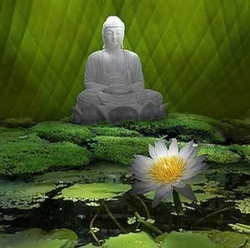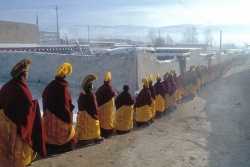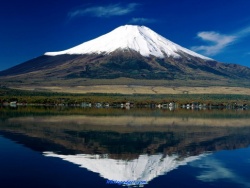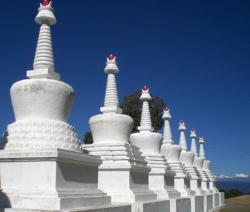Brahmaloka
Brahmaloka; Brahma realm 'Brahma-world', in the widest sense, is a name for the fine-material (rūpa-loka) and immaterial world (arūpa-loka); in a narrower sense, however, only for the first three heavens of the fine-material world. Cf. Brahma-kāyika-deva.
In Hinduism, Brahmapura is the abode of Brahma, one of the three Trimurti. It is located on Mount Meru. It is also referred to as Brahmaloka or Satyaloka in all of the puranas. Brahmapura is the topmost loka within this material universe.
Upanishads, Advaita
In the Puranas, and already in the Atharvaveda, there are fourteen worlds, seven higher ones (vyahrtis) and seven lower ones (patalas), viz. bhuu, bhuvas, svar, mahas, janas, tapas, and 'satya' above and atala, vitala, sutala, rasaataala, talatala, mahaatala, patala and naraka below.
During each pralaya, the lower ten realms (loka) are destroyed while the higher four realms, including Satya-loka, Tapa-loka, Jana-loka, and Mahar-loka are preserved. During each Mahapralaya, all 14 realms are destroyed.
The Chāndogya Upaniṣad says in 8:1:1 that within the Brahmapura "is an abode, a small lotus-flower within which is a small space (antarakasa). What is within that, should be searched out; that, assuredly, is what one should desire to understand."
Further there are Hiranyapura (golden city) and Siddhapura or White Island.
Trimurti
Brahma loka, Vaikuntha loka (Vishnu), Shiva loka are seen as the same and form together the highest loka (dimension) of the 14 lokas. 'Satya loka' is at their top and can be looked at as the lowest plane of Para Brahman.
Narayana is also venerated as Para Brahman and therefore to pervade all the 14 lokas and the entire Brahmanda (Universe) which includes both manifested (planets, stars, galaxies, black holes, etc. which constitute 25% of the Universe) and unmanifested (the unknown dark matter which constitutes 75%) energy. Lord Vishnu who is said to live in Vaikuntha is a finite form of the infinite formless, timeless Narayana.
Buddhism
Here is Brahmaloka the highest of the celestial worlds, the abode of the Brahmas. It consists of twenty heavens : the nine ordinary Brahma-worlds, the five Suddhāvāsā, the four Arūpa worlds, the Asaññasatta and the Vehapphala (e.g., VibhA.521).
The highest of the celestial worlds, the abode of the Brahmas. It consists of twenty heavens:
the nine ordinary Brahma-worlds,
the five Suddhāvāsā,
the four Arūpa worlds (see loka),
the Asaññasatta and
the Vehapphala (e.g., VibhA.521).
All except the four Arūpa worlds are classed among the Rūpa worlds (the inhabitants of which are corporeal). The inhabitants of the Brahma worlds are free from sensual desires (but see the Mātanga Jātaka, (J.497), where Ditthamangalikā is spoken of as Mahābrahmabhariyā, showing that some, at least, considered that Mahābrahmas had wives).
The Brahma world is the only world devoid of women (DhA.i.270); women who develop the jhānas in this world can be born among the Brahmapārisajjā (see below), but not among the Mahābrahmas (VibhA.437f). Rebirth in the Brahma world is the result of great virtue accompanied by meditation (Vsm.415). The Brahmas, like the other celestials, are not necessarily sotāpanna or on the way to complete knowledge (sambodhi-parāyanā); their attainments depend on the degree of their faith in the Buddha, the Dhamma and the Sangha. See, e.g., A.iv.76f.; it is not necessary to be a follower of the Buddha for one to be born in the Brahma world; the names of six teachers are given whose followers were born in that world as a result of listening to their teaching (A.iii.371ff.; iv.135ff.).
The Jātakas contain numerous accounts of ascetics who practiced meditation, being born after death in the Brahma world (e.g., J.ii.43, 69, 90; v.98, etc.). Some of the Brahmas - e.g., Baka - held false views regarding their world, which, like all other worlds, is subject to change and destruction (M.i.327). When the rest of the world is destroyed at the end of a kappa, the Brahma world is saved (Vsm.415; KhpA.121), and the first beings to be born on earth come from the ābhassara Brahma world (Vsm.417). Buddhas and their more eminent disciples often visit the Brahma worlds and preach to the inhabitants. E.g., M.i.326 f.; ThagA.ii.184ff.; Sikhī Buddha and Abhibhū are also said to have visited the Brahma world (A.i.227f.). The Buddha could visit it both in his mind made body and his physical body (S.v.282f.).
If a rock as big as the gable of a house were to be dropped from the lowest Brahma-world it would take four months to reach the earth traveling one hundred thousand leagues a day. Brahmas subsist on trance, abounding in joy (sappītikajjhāna), this being their sole food. SA.i.161; food and drinks are offered to Mahābrahmā, and he is invited to partake of these, but not of sacrifices (SA.i.158 f.). Anāgāmins, who die before attaining arahantship, are reborn in the Suddhāvāsā Brahma-worlds and there pass away entirely (see, e.g., S.i.35, 60, and Compendium v.10). The beings born in the lowest Brahma world are called Brahma-pārisajjā; their life term is one third of an asankheyya kappa; next to them come the Brahma-purohitā, who live for half an asankheyya kappa; and beyond these are the Mahā Brahmas who live for a whole asankheyya kappa (Compendium, v.6; but see VibhA.519f., where Mahā Brahmās are defined).
The term Brahmakāyikā-devā seems to be used as a class-name for all the inhabitants of the Brahma-worlds (A.i.210; v.76f).
The Mahā Niddesa Commentary (p.109) says that the word includes all the five (?) kinds of Brahmā (sabbe pi pañca vokāra Brahmāno gahitā).
The BuA.p.10 thus defines the word Brahmā: brūhito tehi tehi gunavisesahī ti=Brahmā. Ayam pana Brahmasaddo Mahā-Brahma-brāhmana-Thathāgata mātāpitu-setthādisu dissati.
The Samantapāsādikā (i.131) speaks of a Mahā Brahmā who was a khināsava, living for sixteen thousand kappas. When the Buddha, immediately after his birth, looked around and took his steps northward, it was this Brahmā who seized the babe by his finger and assured him that none was greater than he.
The names of several Brahmās occur in the books - e.g.,
Tudu
Nārada
Ghatikāra
Baka
Sanankumāra
Sahampatī
To these should be added the names of seven Anāgāmīs resident in Avihā and other Brahma worlds
Upaka
Phalagandu
Pukkusāti
Bhaddiya
Khandadeva
Bāhuraggi
Pingiya
(S.i.35, 60; SA.i.72 etc.).
Baka speaks of seventy two Brahmās, living, apparently, in his world, as his companions (S.i.142).
See also Tissa Brahmā.
These are described as Mahā Brahmās. Mention is also made of Pacceka Brahmās - e.g., Subrahmā and Suddhavāsa (S.i.146f).
Tudu is also sometimes described as a Pacceka Brahmā (e.g., S.i.149). Of the [[Pacceka [Brahmās]], Subrahmā and Suddhavāsa are represented as visiting another Brahmā, who was infatuated with his own power and glory, and as challenging him to the performance of miracles, excelling him therein and converting him to the faith of the Buddha. Tudu is spoken of as exhorting Kokālika to put his trust in Sāriputta and Moggallāna (Loc. Cit.)
No explanation is given of the term Pacceka Brahmā. Does it mean Brahmās who dwelt apart, by themselves? Cp. Pacceka-Buddha.
The Brahmās are represented as visiting the earth and taking an interest in the affairs of men. Thus, Nārada descends from the Brahma-world to dispel the heresies of King Angati (J.vi.242f). When the Buddha hesitates to preach his doctrine, because of its profundity, it is Sahampati who visits him and begs him to preach it for the welfare of the world. The explanation given (e.g., at SA.i.155) is that the Buddha waited for the invitation of Sahampati that it might lend weight to his teaching. The people were followers of Brahmā, and Sahampati's acceptance of the Buddha's leadership would impress them deeply.
Sahampatī is mentioned as visiting the Buddha several times subsequently, illuminating Jetavana with the effulgence of his body. It is said that with a single finger he could illuminate a whole Cakkavāla (SA.i.158). Sanankumāra was also a follower of the Buddha. The Brahmās appear to have been in the habit of visiting the deva worlds too, for Sanankumāra is reported as being present at an assembly of the Tāvatimsa gods and as speaking there the Buddha's praises and giving an exposition of his teaching. But, in order to do this, he assumed the form of Pañcasikha (D.ii.211ff).
The books refer (e.g., at D.i.18, where Brahmā is described as vasavattī issaro kattā nimmātā, etc.) to the view held, at the Buddha's time, of Brahmā as the creator of the universe and of union with Brahmā as the highest good, only to be attained by prayers and sacrifices. But the Buddha himself did not hold this view amid does not speak of any single Brahmā as the highest being in all creation. See, however, A.v.59f., where Mahā Brahmā, is spoken of as the highest denizen of the Sahassalokadhātu (yāvatā sahassalokadhātu, Mahā-Brahmā tattha aggam akkhāyati); but he, too, is impermanent (Mahā-Brahmūno pi . . . atthi eva aññathattam, atthi viparināmo).
There are Mahā Brahmās, mighty and powerful (abhibhū anabhibhūto aññadatthudaso vasavattī), but they too, all of them, and their world are subject to the laws of Kamma. E.g., at S.v.410 (Brahmaloko pi āvuso anicco adhuvo sakkāyapariyāpanno sādhāyasmā Brahmalokā cittam vutthāpetvā sakkāyanirodhacittam upasamharāhi). See also A.iv.76f., 104f., where Sunetta, in spite of all his great powers as Mahā Brahmā, etc., had to confess himself still subject to suffering.
To the Buddha, union with Brahmā seems to have meant being associated with him in his world, and this can only be attained by cultivation of those qualities possessed by the Brahmā. But the highest good lay beyond, in the attainment of Nibbāna. Thus in the Tevijjā Sutta; see also M.ii.194f.



